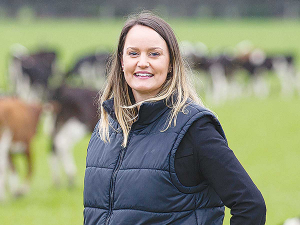Farmer confidence dips slightly, but positivity still dominates
Farmer confidence has taken a slight dip according to the final Rabobank rural confidence survey for the year.
 RaboResearch’s Emma Higgins is remaining cautious regarding commodity prices with New Zealand heading into peak milk production.
RaboResearch’s Emma Higgins is remaining cautious regarding commodity prices with New Zealand heading into peak milk production.
Falling dairy prices in recent months are putting this season’s forecast milk payout under strain.
While Fonterra is maintaining its wide range milk price of $5.90 to $6.90/kgMS for this season, analysts aren’t ruling out trimming their forecast payouts if prices continue to head south.
A higher NZ dollar is also likely to negatively impact NZ dairy sector returns.
Westpac senior agri economist Nathan Penny says he remains cautiously optimistic on the outlook, but risks remain high.
Despite the price fall in last week’s Global Dairy Trade (GDT) event, current prices remain consistent with the bank’s $6.50/kgMS forecast.
“However, while we had allowed for prices to fall, we are running out of runway,” he says.
“In other words, if dairy prices continue to fall over coming auctions, noting that the largest auctions for the season are near, we will consider revising our milk price forecast lower.”
ASB senior economist Chris Tennent-Brown says its forecast of $6.75/kgMS “is under some pressure”.
“We will review our outlook after the next GDT auction and Fonterra announcement,” he says. Fonterra announces its full-year results next week.
RaboResearch’s Emma Higgins says she remains cautious regarding commodity prices as New Zealand heads into peak milk production.
Higgins notes that upwards currency movements are also a bit of a headache for exporters right now, with the NZ/US cross inching higher to sit at 67 cents.
“We do, however, expect recovery in the foodservice channel to continue to improve – this will be an important watch for ensuring market balance.
“We are pulling together the next Global Dairy Quarterly report over the next couple of weeks and will be re-assessing our view on the global dairy market fundamentals.”
Fonterra chairman John Monaghan wrote to shareholders last week asking them to remain cautious with on-farm financial decisions.
Monaghan says the global dairy market is finely balanced at the moment, with both demand and supply increasing but it has the potential to change.
“There is good demand in market at this stage of the season, however, the forecast economic slowdown is likely to increase global unemployment and reduce consumer demand,” he says.
|
A landmark moment for New Zealand. That's how Prime Minister Christopher Luxon describes the conclusion of negotiations for an India-New Zealand Free Trade Agreement. Beef Progeny Test 2025: Genetic insights for NZ beef industryAt Pāmu’s Kepler Farm in Manapouri, mating has wrapped up at the across-breed Beef Progeny Test. HortNZ celebrates 20 YearsMore than 150 people turned up at Parliament recently to celebrate the 20th anniversary of Horticulture New Zealand (HortNZ). Biosecurity NZ urges vigilance for yellow-legged hornetsBiosecurity New Zealand says Kiwis should continue to keep an eye out for yellow-legged hornets (Vespa velutina) over the holiday season. Mental Health and Fitness Unite: The Push-Up Challenge comes to New ZealandThe Push-Up Challenge, an event which combines mental health and fitness, is set to launch in New Zealand in 2026. Agritechnica 2025: Claas, Fendt and Valtra claim 2026 Tractor of the Year AwardsLast month's Agritechnica event led to a wide group of manufacturers celebrating successes when the 2026 Tractor of the Year Competition winners, selected by a panel of European journalists, were announced in Hanover Germany. NationalAlliance commissions major heat pump system at Mataura, cutting coal use and emissionsAlliance Group has commissioned a new heat pump system at its Mataura processing plant in Southland.NZ meat industry seeks removal of US 15% lamb tariffMeat processors are hopeful that the additional 15% tariff on lamb exports to the US will also come off.Early drought fears ease in Hawke’s Bay, but caution remainsFears of a serious early drought in Hawke’s Bay have been allayed – for the moment at least.Consent Rollovers and $13b Savings: What the new RMA bills could meanThere was much theatre in the Beehive before the Government's new Resource Management Act (RMA) reform bills were introduced into…Rural bias?OPINION: After years of ever-worsening results from our education system, the startling results from a maths acceleration programme stood out like…Machinery & ProductsAgriSpread AS3000 Bulk Spreader: Precision spreading up to 52mManufactured in Ireland, tested and launched at Agritechnica in Germany, AgriSpread’s new AS3000 bulk spreader takes much of the technology…Agritechnica 2025: Claas, Fendt and Valtra claim 2026 Tractor of the Year AwardsLast month's Agritechnica event led to a wide group of manufacturers celebrating successes when the 2026 Tractor of the Year…New Case IH Puma series debuts with improved design & precision techCase IH used Agritechnica to reveal its new Puma series tractor, featuring what it claims is an entirely new vehicle…New Holland unveils “Il Trattore” concept at AgritechnicaCreating a great deal of enthusiasm at Agritechnica, the T5.120 ‘Il Trattore’ styling concept tractor was celebrating the legacy of…Deutz-Fahr unveils all-new 8 series tractor range at AgritechnicaAgritechnica was the launchpad for several “new” tractors, most reworks of existing models, but Deutz Fahr ‘s new 8 Series was…» Latest Print Issues OnlineThe Hound
Yes, Minister!OPINION: The release of the Natural Environment Bill and Planning Bill to replace the Resource Management Act is a red-letter day… Two-legged pestsOPINION: Federated Farmers has launched a new campaign, swapping ‘The Twelve Days of Christmas’ for ‘The Twelve Pests of Christmas’ to… » Connect with Rural News» eNewsletter |